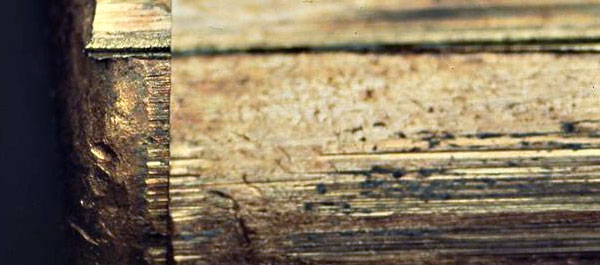Principles of Firearms Examination
The basis for firearms identification is founded on uniqueness: upon close examination, virtually all objects can be distinguished from one another, and the same is true for firearms. Fortunately for criminal investigators, the uniqueness of each firearm transfers to the cartridge case and bullet whenever the weapon is fired. This has been proven through physical sciences including physics, metallurgy, metallography and materials science.
The firearm’s surfaces (firing pin/striker, breach, barrel, etc.) that contact the softer cartridge case and bullet contain random, unique, microscopic irregularities that make it different from other firearms - even those of the exact same model. These differences can be used to identify or eliminate a weapon as being used in a crime, if a cartridge case or bullet is recovered at the crime scene. This is done by comparing the markings made on the cartridge cases or bullets when fired, using the firearms examiner’s key tool: the comparison microscope.
In conjunction with this, the examiner has the ability to explain how a firearm functions and what safety features a firearm might have. This can have an impact on investigations of suicides, unintentional shootings and accidental firearm discharge.
General Rifling Characteristics
There are several general characteristics associated with firearms that can help lead the investigation. These include the caliber (bore diameter) of the barrel, the number and dimension of the grooved impressions inside a gun barrel, and the direction of the twist of these rifling grooves (clockwise or counterclockwise).

Rifling grooves on the barrel of a revolver. (Courtesy of Scott Campbell, Ron Smith & Associates)
To help stabilize the flightpath of a bullet, manufacturers cut spiral grooves into the gun barrel. This pattern of grooves on the barrel leaves corresponding raised and lowered areas on the surface of the bullets fired from it. Measuring the number and width of these gross impressions can help firearms examiners narrow the range of possible weapons to a particular class of firearm. (Note: Some manufacturers use a technique called polygonal rifling that doesn’t allow for this type of assessment due to the rounded profile of the rifling pattern.)
Individual Characteristics
While general characteristics can lead investigators to conclude that the bullet or cartridge was fired from a particular class of firearm, such as a .45 caliber revolver, other more specific marks can help identify the make and model of firearm that was used. These individual characteristics can be marks produced by random imperfections during manufacturing or irregularities caused by use, corrosion or damage.

Comparing groove impressions on a bullet recovered from a crime scene (left) to a bullet fired from a .357 magnum (right) under 20× magnification. (Courtesy of NFSTC)

Comparison of a cartridge case recovered from a crime scene (left) to a cartridge case fired from a .357 Magnum (right) under a comparison microscope at 15× magnification. (Courtesy of NFSTC)